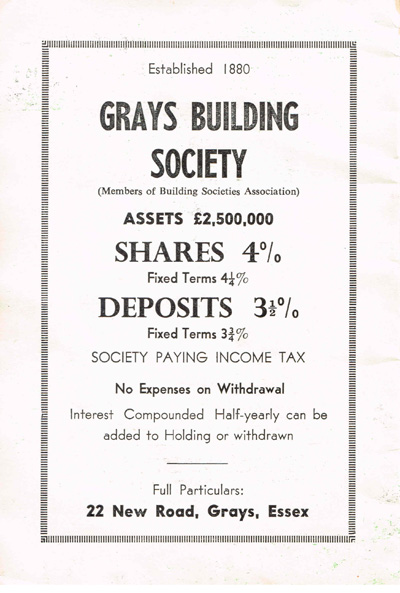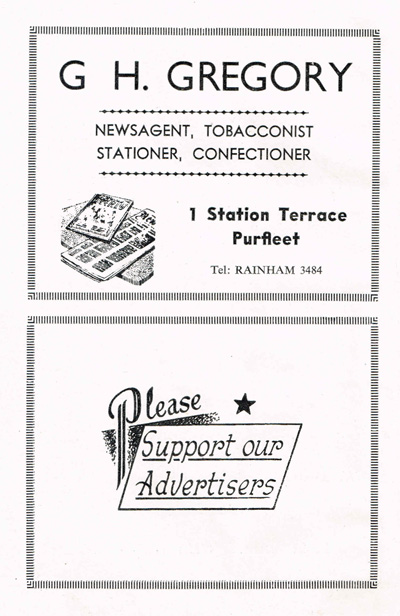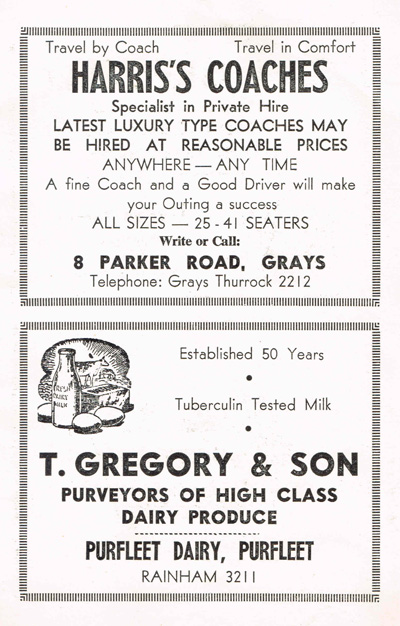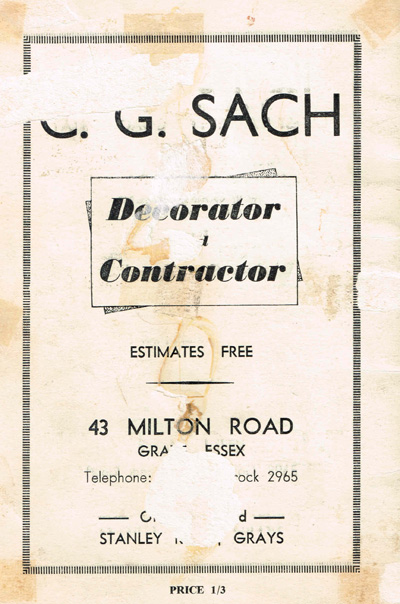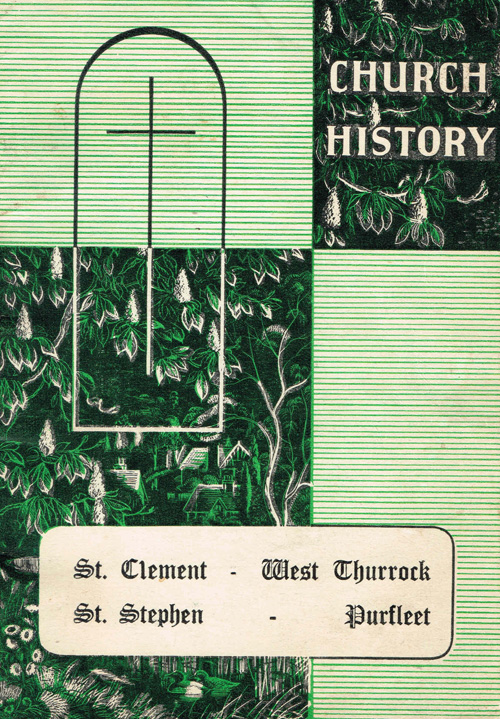
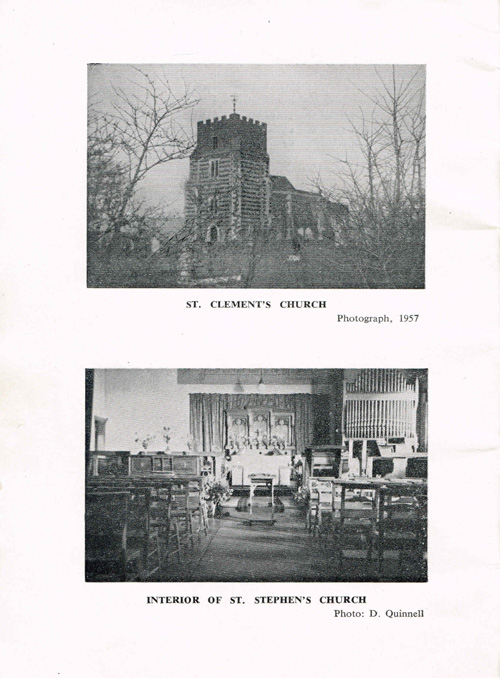
Remotely situated, close to the river, St. Clement's presents quite an endurance test to the worshipper. In 1650 a Church Commission issued the following statement: "The Parish Church standeth in so bleak a place that it tends much to the impaiying the health both of Minister and people, by which the public service of God is much neglected, that the parishioners desire some other place may be appointed about the middle of the Parish for that purpose.Three hundred years later the Church is still reposing in its original position, and as a scheduled ancient monument at the Ministry of Works, cannot now be moved.
For those who have been puzzled about the isolated position of the Church, the following explanation is offered in a newspaper cutting, collected by the Rev. J. W. Hayes in his book, History of West Thurrock and Purfleet." It seems that it was originally intended to build the Church in Purfleet, but after the workmen had laid the foundations the devil removed them at night. and re-laid them where the Church now stands. That the Church has thrived on such ignoble workmanship, indicates we presume, the devil's defeat!
The same newspaper article gives an interesting account of St. Clement, patron saint of sailors, who suffered under the Roman persecution; was arrested, and thrown into the sea accompanied by an anchor attached to his neck. This display of Roman chivalry resulted in the building of a number of churches, situated by the sea in remembrance of St Clements
St Clement's Reach or Fiddlers Reach (the name given to the part of the Thames near the Church), has also given rise as might be expected to a fabulous story. Some fiddlers journeyed over from Kent one murky night, wrestled with three of the six bells, and in the effort of transporting them back to their own county, placed too much strain on their vessel, and were drowned. A more likely explanation is that from the 15th to the 17th centuries there existed some adventurous seafaring gentlemen, who appreciated the more intoxicating spirits in life, and used the belfry and the cavity in the pulpit as storage cupboards. This explanation is supported by the fact that during this period one Hynes, " Fiddler the Pirate," was arrested in the taproom at the " White Hart " at Burnham, executed and hanged in chains at Fiddlers Point, Greenhithe. Also, Mr. Hayes, during one of his many explorations, discovered many coffins in a vault in the Church, one of which was dated 1723 and bore the name of Nathaniel Grantham, a well-known naval commander. When Mr. Hayes rolled back the lead of this coffin he found the well-known sailor's beverage, rum.
Imagine that you have crossed the railway line and are standing outside the Church gate. To your right there is an old mounting-block or the " Pilgrim's Stone," which inspires the imagination to see elegant lords, weary pilgrims�or more probably, naughty boys. scorning a dignified entrance, and tearing their trousers as they go over the wall before being transformed into cherubic choristers.
Still outside the Church, you will find an iron plate on the right of the building, which covers the last evidence of a discovery which excited archeologists and dated the Church earlier than was once supposed foundations of a circular nave. This is a characteristic of Saxon architecture and throughout Great Britain only thirteen such Churches have been discovered. Of these only four are still in use, St. Clement's being the smallest on record in England.
Architecturally, the Church has undergone many changes; the chancel and its window are 13th century, some of the windows in the aisle, the North chantry and the lower half of the tower 14th, and the upper half of the tower 17th century.
The South chantry was built in " vulgar style " shortly after 1711 when the South wall fell.
Owing to the additions of the two aisles and chantries in the 13th century, the length of the Church was less than its width, and in order to remedy this the wooden partition and the doors were brought back about ten feet into the porch. This increased the apparent length of the nave and provided more seating accommodation.
Over the wooden doors you can see the Hastings coat of arms; Count Robert d'Eu was presented with West Thurrock by William the Conqueror, as a token of his gratitude after the Battle of Hastings.
The Count built the castle of Hastings and founded a collegiate Church within the Castle, and this provided West Thurrock with its Canons and Rectors. Thomas � Becket was at one time Dean of this College and therefore had close connections with St. Clement's.
After Becket's death and consequent canonisation, the Church became most important as a convenient house of prayer for the pilgrims on their way to Becket's shrine in Canterbury.
If you look carefully at the wall by the font you will find another reminder of the pilgrims in the shape of a Knights Templars badge. This great order was founded in 1118, nineteen years after the conquest of Jerusalem, by nine knights who expressed the intention of removing all infidels and robbers from the highways leading to Jerusalem and to protect the pilgrims journeying to the Holy Sepulchre. They wore white mantles over their armour and later adopted a blood-red cross. At West Thurrock they had a Commandery of 50 men. As a result of false charges brought against them, they were abolished by the Pope in 1312, and their lands handed over to the Kights Hospitallers. All that remains of their connections with St. Clement's Church is the small badge set in the wall, and two small circular windows set above the Holy Table in the East wall.
Take a few steps forward into the 13th century and examine the font, decorated with a flower, cross and lamb, which was treated in the 19th century to resemble marble or granite.
Also to this century belongs the tomb of a Canon which you will find in the North chantry. It was discovered under the effigy of Sir Christopher Holford, and is described as "a stone coffin roughly hewn, and having three drainage holes in the bottom.
More medieval mystery is contained in the Priest's doors now no longer used, while the piscina has such an aura of romance surrounding its name and appearance, that its practical function is most disappointing. These Eastern-looking niches there are two one in the North chantry and a double one by the Communion rails, are nothing but water drains, containing a stone basin, in which the Priest washed his hands and rinsed the chalice after the celebration of Mass. The niche by the Communion rails contains wooden shelves on which are placed the sacred elements, and the offertory plate.
De Langton cuts a " Dark Ages " picture of notoriety. Canon of St. Clement's in 1290, he appeared before the Pope, charged with "diverse enormities" namely murder, adultery, simony, and communication with the devil. After breaking a considerable four of the ten commandments he was buried in Lichfield Cathedral !
One feels that justice was hardly done, when three centuries later the unfortunate Richard Reynolds, Vicar, in 1578, was expelled for ignorance, despite his D D and authorship of four works. Sir Thomas Bourghier however; Reynolds predecessor by a century, brought honour to St. Clement's when he became Archbishop of Canterbury.
We can also boast of an eminent patron (about the same time as Bourghier), Lord Rivers, father of Elizabeth Woodville, who first married Lord Gray from whom we get the name of our town then later became the wife of Edward IV and mother of the two little princes murdered in the Tower. She lived at Purfleet.
A more recent figure connected with the Church is the Rev. J. W. Hayes, Vicar from 1902 to 1921, whose interest in St.Clement's prompted him to write " History of West Thurrock and Purfleet." This " labour of love " as he calls it, contains much useful and amusing information. One charming anecdote in his book concerns the bells which distracted Dr. Nolan to such a degree that he entered the belfry with a carving knife, and with a threatening gesture expressed the following desire.
Your bells are always ringing;
I wish the ropes around your necks
And you upon them swinging."
Mr. Hayes also recalls the custom which entailed the indulgence in sherry and biscuits between Prayers and the Sermon. As one can see from the material he collected, he had a keen sense of humour. This is well illustrated by the occasion on which the gas light failed in the Parish Hall while he was conducting a service. Quite undisturbed he sent for a carbide lamp from the " Ship " hotel opposite, and continued his meeting by that light.
If we return to the piscina by the Communion rails and turn away to the chancel floor, we will find brasses of the Heies family (see illustration) These 17th century figures are quite remarkable for the intricate working which shows clearly the elaborate dress of the period, and also for a Latin verse punning the family name. To the same century belong the effigies of the Holfords, patrons in 1607. These two figures which are of special interest for the careful planning and artistry of the man's armour and the woman's dress, are all that is left of a very handsome monument.
All these are in the Church, but buildings are cold, and stone people cannot speak it is the writing of a period which makes the contact between people of different centuries. St. Clement's is rich in writing of the 18th and 19th centuries; one parchment bound book contains bills dating from 1740, and the correspondence and details of Poor Law relief are a rap on the knuckles.
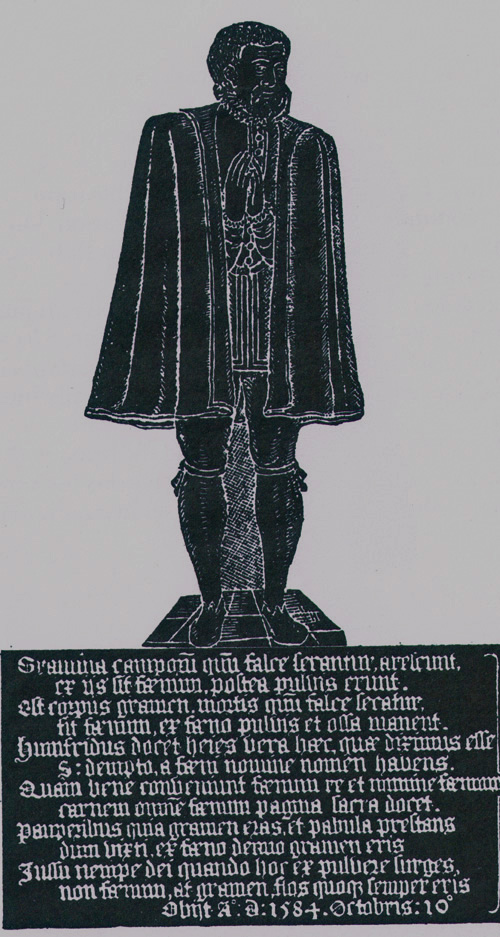
The grass, cut by the scythe, dries and turns to Heie.
And afterwards to dust, so follow they.
All flesh is grass: Death cuts, and this again
Will turn to Heie, and then as dust remain.
Let Humphrey Heie the truth of this confess,
Who gets his name of Heies, omitting s.
How well the Heie in fact and Heie in name
Agree, let Scripture tell there both the same.
To poor, thou was as Grass and food on earth
From Heie to grass will be thy coming birth
For, when God bids his dust to rise, thou'lt
Be Not Heie but Grass, and flower eternally.
He died October 10th 1584
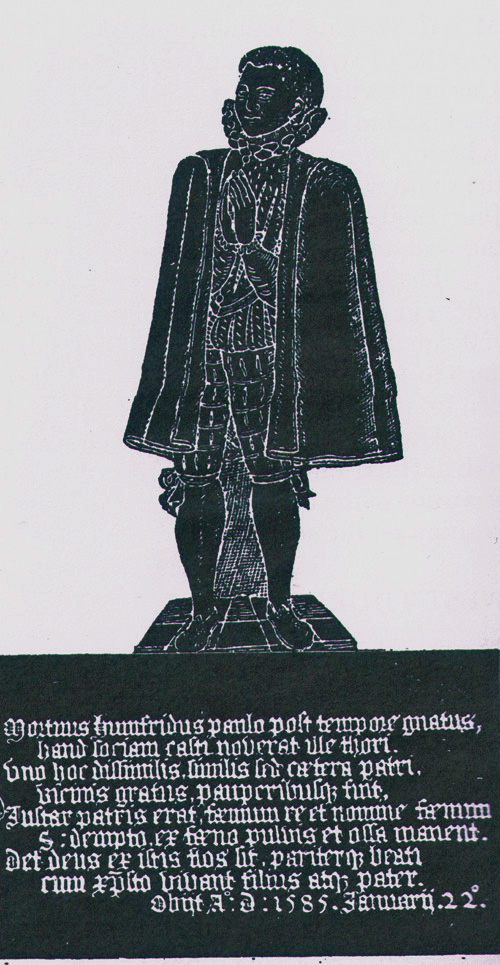
Soon Humphrey died, the Son unlike in this
He not of chaste wedlock known the bliss.
In all else, like his father�far and near
To all around, both rich and poor, as dear.
Like him, too, he was Heie in fact and name.
Till, like his father, Heie like dust became.
God grant a flower may spring of it; and may
Both live with Christ in blessedness, we pray.
He died January 22nd 1585.
For the " good old days romantics. For those interested in the rising cost of living cement cost 1/6d. per ton, but in 1803 a four-page newspaper cost 6d. and a Marriage Licence 10 shillings a case in point for the Chancellor of the Exchequer.
A pathetic note is evident in the following notice of 1766 : The Overseer will sell to the poor according to the number in their families, every Monday morning, between 8 and 10 o'clock, rice at 2d. per pint, spice and treacle at a low price, for ready money only." The notice then went on to give two recipes, for rice pudding and rice dumplings, and continued with the following information, " quart of rice, bought for 4d., seasoned with a halfpenny's worth of spice and Id. worth of treacle will make 6 pounds of good, solid food. A quarten loaf which weighs four pounds costs 15d."
The Poor Law provided Parish officers with the means to assist their poor. Unfortunately the means were small, the needs great, and there is evidence of much suffering and affiction.
Interesting to compare with present-day statistics are the following figures found in a census taken in 1821. At that time there were 277 persons living in West Thurrock, composing 73 families, 70 of vvhich were employed in agriculture.
Another book containing the Vestry Minutes of the years 1799 to 1802, records meetings held in the " Ship " and the Fox & Goose." This is made particularly amusing when, some pages later, during a meeting in one of the above mentioned establishments, it was decided that all those who wasted their money in a public house (written with such righteous indignation), should be denied relief ! The Churchwardens at that time were extremely practical, and there is a minute to the effect that the Parish Cage should be removed and used for repairing the Church fence as prisoners no longer experienced such ignominy, but were taken instead to the Police Station.
Much of the above book contains plans providing for the poor. One case concerned a Workhouse in Wennington which the united parishes of West Thurrock, Aveley and Rainham, were to uphold by sending 2/6d. for each person every month. This was to be spent on " Goods and wholesale bread, meat and all other victuals, and small beer." Other minutes tell of allowances for clothes, shifts and shoes�and the careful generosity of the Church Officers shows a humane understanding of a responsibility which has now been transferred to the State.
So we have a picture of the ancient and modern. The 17th century Holfords are now illuminated by electric light, the Handsome stoves " of the Rev. J. W. Hayes era are replaced by modern oil heaters,- and the priests doors have become a forgotten element of mystery. The industrial scene predominates �the picturesque sailing boats have been supplanted by the efficient and " dirty British coaster with the salt-caked smokestack "�but the romance is there if the visitor is aware of history.
During its long existence the Church has seen the darkness of medieval superstition descend, and the light of the Reformation kindled to dispel it. This change is symbolised by the empty niches in the North chantry where images once stood, and the large open Bible in the English language now standing at the chancel step. By Word and Sacrament the message of the redeeming love of God in the Lord Jesus Christ is proclaimed continually and the reader's prayers are asked, for the Holy Spirit's blessing upon that proclamation.
Having been linked to West Thurrock ecclesiastically through the centuries, Purfleet has no ancient Church to which it can point with pride, and although an ambitious attempt was made in the 1920's to establish it as a separate parish, it is still part of " West Thurrock with Purfleet," due to its development (by Government direction), industrially and not residentially.
Purfleet's name is derived from Pourt (e) Flet (e), being the mouth (poure) of the Flet(e) now called the Mardyke. The ancient Manor of Purfleet had no Church of its own, save a private chapel attached to the Manor House at various times known as " La Vineyard," " West Hall," and now " High House." This chapel has long since disappeared, although High House still remains.
So far as is known, there is no other record of a Church at Purfleet until 1791, although John Wesley records in his diary of January 6th, 1784, that he preached " to a large and attentive congregation " at Purfleet, and stayed the night. As he frequently preached in the open air, however, this is no proof of the existence of a Church.
Prior to the 18th century Purfleet had been a hamlet with a few cottages and a ferry across the river. Its only industry was chalk digging and limeburning, the former gradually reducing a great headland (seen in the etching opposite page 11), to a huge hollow rightly named " The Dipping." Then about 1760 the Government established a gunpowder store with buildings to house a military guard and workmen, whilst about 1790 Mr. Samuel Whitbread, a London brewer, built himself a country mansion which he called " Purfleet House." This had all the customary outbuildings, stables, coach-house, laundry, and in the Dipping a Chapel-of-ease where his family and wor kers could worship, and which in after years was given over for Church of England services under the Vicar of West Thurrock.

So Purfleet acquired a Church an unpretentious square brick building with no tower, its bell hung from a tree. It had a gallery, used for many years by boys from the Training Ship Cornwall," an old " Wooden Wall " which was moored at Purfleet from 1859 to 1926.
In this building the inhabitants of Purfleet worshipped until the Whitbread family decided to sell the estate in 1920. The then Vicar (the Rev. J. W. Hayes), purchased on behalf of the Church authorities Purfleet House and the Dipping, including the Chapel and the old school-house nearby. The Mansion and the land immediately surrounding it were retained for the site for a new Church, and the rest (including the Chapel-of-ease) were sold. The Chapel-of-ease was later converted into a private house.
Hence it became necessary to erect a new building at once, and a scheme was prepared to demolish part of Purfleet House, and with the materials build a Parsonage House with a temporary Church nearby, which could eventually become a hall for meetings, etc., when a permanent Church was erected. A plan to use the main walls of Purfleet House as the shell of this permanent church was also proposed. In the event, the temporary Church became permanent, and Purfleet House itself was pulled down in 1951 having become dangerous.
The present building is equipped to serve as a Church and has a pipe-organ, and contains a number of memorial tablets. One to Maud Whitbread was transferred from the original Chapel-of-ease, the others are
2. Memorial to Walter William Dixson.
3. Memorial to Timon Walter Lockyer.
4. Brass pulpit lectern in memory of Emily Agnes Sunnocks and her husband and family.
In addition the Holy Table was presented by employees of Thames Board Mills Ltd., as a memorial to Edwin Burton Fiske, the first managing director of the company, and a set of Communion linen was given in memory of another director, William Grant Fiske, by his daughter.
When the present Church was first planned the Wardens invited members to purchase individual items of furniture. The choir stalls were provided in this way, and bear small brass plates with the donors' names. Similarly the Font was bought by subscriptions from the children in the Sunday School. Two relics of the Chapel-of-ease, the bell and the pulpit, were incorporated in the new building. The Communion plate was given by the Whitbread family and bears " Poorfleet " as the name of the village. The silver alms dish is a memorial to Mr. W. W. Dixson.
Although the hopes of becoming a separate parish have faded, Purfleet has its own Parochial Church Council. The Bishop of Chelmsford approved this in 1922 as the distance from West Thurrock was so great, and since 1922 except for some short periods during the war-years, there has been a resident Curate-in-charge under the Vicar of West Thurrock.
In the past 167 years Purfleet has seen remarkable changes from the peaceful rural, riverside scene of the etching opposite page 11, which greeted John Wesley when he preached there, to the maze of derricks, pipelines, jetties and steam-driven, ocean-going monsters which meet the eye today, not to mention the rumble and roar of road tankers and other earth-shaking road and rail traffic which greet the ear by night and day.
Nevertheless, human needs remain the same as they were in 1790 when Purfleet's Chapel-of-ease was built. Since then, Sunday by Sunday, God's provision in our Lord Jesus Christ to meet those needs in the power of the Holy Spirit has been declared. Your prayers are asked for the continuance of this ministry.
ST. CLEMENT'S CHURCH, WEST THURROCK LIST OF RECTORS,
PREBENDARIES AND VICARS SINCE 1066
<1100 Canon Aucher
1170 Osbert de eu
1213 William de Wrotham (Canon)
1253 Ralph de Dunium (Canon)
1290 Walter de Langton (Canon) Became Bishop of Lichfield and Coventry
1302 Edmund de Code (Canon)
1304 Nicholas Fermband (Dean) Buried under the Communion Table
1319 William de Cusancia (Canon) 1345 William Flameranus (Canon)
1357 Thomas de Keynes (Canon)
1367 John William Raus (Canon)
1381 John Stanstede (Canon)
1385 Richard Medford (Canon) became Canon of Windsor and Bishop of Chichester and Salisbury
1386 Richard Clifford (Canon) became Bishop of Worcester and London
1409 John de Hermesthorpe (Canon)
1411 Peter de Alcopasse (Canon)
1414 Sir Thomas Ferriby (Canon)
1432 Sir Thomas Boughier (Canon) became Bishop of Worcester and Ely and Archbishop of Canterbury
1435 Thomas Graunt(Canon) non-resident John Hayne d.
1485 1460 Richard Bole
1468 Lionel Wydeville (Canon) became Bishop of Salisbury
1485 William Pykenham 1509 John Lacey
1553 Ralf Trayford
1564 John Rygate
1578 Richard Reynolds, M.D.
1584 Robert Fryer
1593 John Beckman
1628 Anthony Sadlier
1643 Thomas Swinnerton
1699 James Robertson
1709 Andrew Thompson
1710 William Dashwood
1718 Matthew Mayo
1724 John Tomlyns
1732 John Usgate
1734 Brockhill Newberry
1734 B. Howburgh
1744 Robert Maxwell, D.D.
1763 John Duncombe
1770 Charles J. Gough
1772 J. Collins
1799 William Murgatroyd
1805 John Foster
1838 Frederick Heberden
1863 Elford Copland Lethbridge
1876 Thomas Aldersey Morley
1895 Trevor J. Hamilton Carson
1902 Joseph Walter Hayes
1921 Affred Norton
1927 Ralph Williams
1934 Frederick Carpenter
1937 Robert Benjamin Porter
1944 Eric Hedley Holliday
1955 Edgar George Stride
